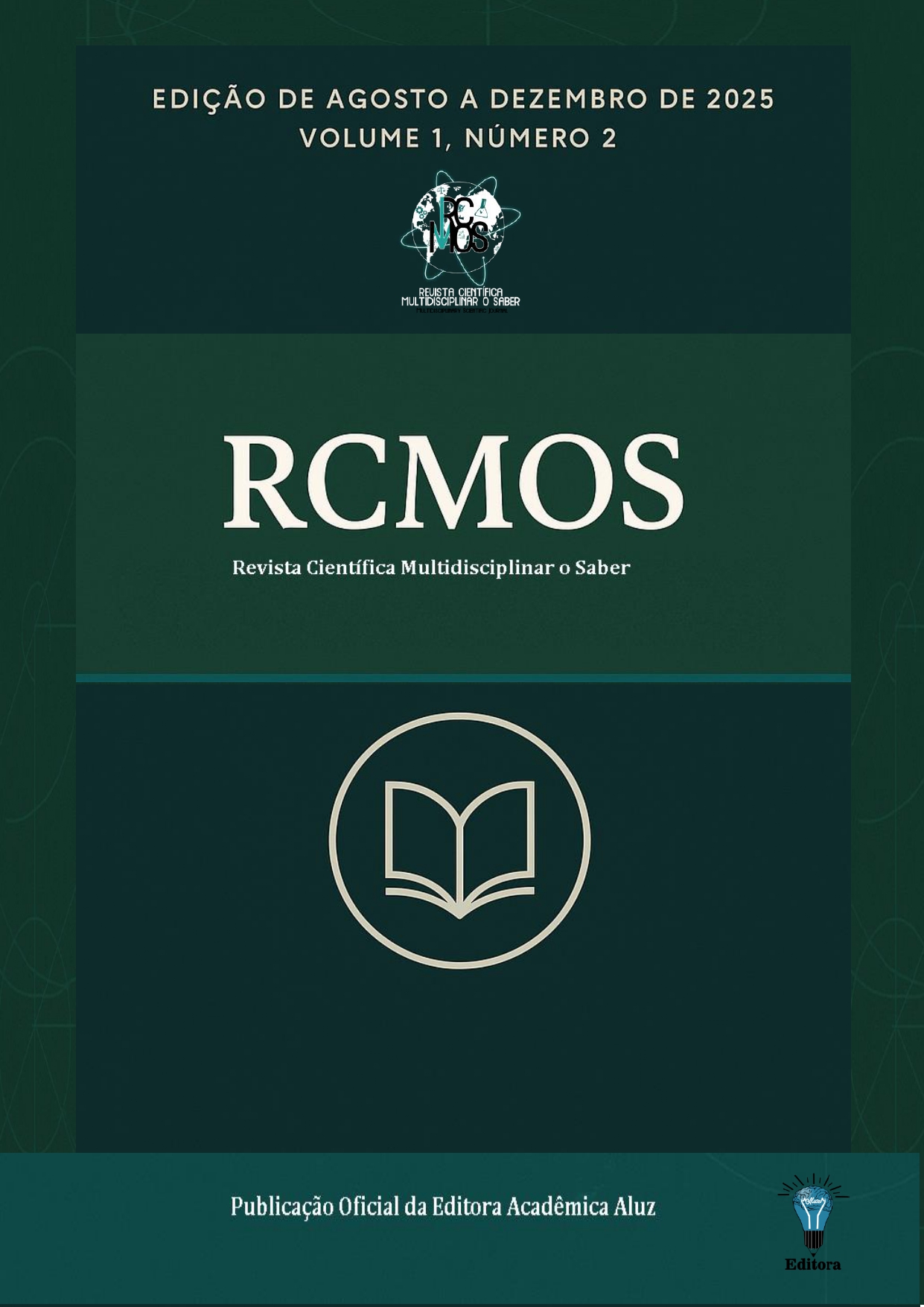Vertical transmission of Streptococcus Agalactiae: systematic review of scientific literature
Vertical transmission of Streptococcus Agalactiae: systematic review of scientific literature
DOI:
https://doi.org/10.51473/rcmos.v1i2.2025.1513Keywords:
Streptococcus agalactiae. Infectious Disease Transmission, Vertical. Pregnant women. Infant, Newborn.Abstract
This study aimed to conduct a systematic review on maternal colonization by Streptococcus agalactiae (GBS), vertical transmission rates, and associated risk factors across different geographic and socioeconomic contexts. A literature search was performed in PubMed/MEDLINE, Embase, and SciELO. Original studies published in peer-reviewed journals, available in full text, without temporal restriction, addressing maternal colonization prevalence, vertical transmission rates, and/or associated risk factors were included. Only studies involving pregnant women and newborns up to 90 days of age, published in English, Portuguese, or Spanish, were considered, while reviews, case reports, letters to the editor, editorials, conference proceedings, and studies with exclusively animal or in vitro samples were excluded. Data were organized into comparative tables, enabling descriptive synthesis and qualitative analysis. The review identified wide variability in maternal colonization prevalence (4.8% to 32%) and vertical transmission rates (0.0% to 72.3%). The average vertical transmission rate across the included studies was approximately 21% (21.8% by simple mean; 21.2% weighted by sample size), reflecting the variable impact of prophylaxis practices and population differences. Studies with systematic intrapartum prophylaxis reported minimal transmission, whereas contexts without universal screening exhibited high rates. Recurring risk factors included premature rupture of membranes, prolonged labor, prematurity, and low maternal IgG levels. Methodological and geographic heterogeneity underscores the need for universal screening, effective prophylaxis, and continuous surveillance. Furthermore, only a small proportion of identified studies provided data on vertical transmission, highlighting a gap in the literature. In conclusion, these findings emphasize the importance of maternal screening policies, consistent implementation of intrapartum prophylaxis, and maternal immunization strategies to reduce Streptococcus agalactiae vertical transmission and prevent early neonatal infections.
Downloads
References
ALI, Musa Mohammed et al. Prevalence of group B streptococcus among pregnant women and newborns at Hawassa University comprehensive specialized hospital, Hawassa, Ethiopia. BMC Infectious Diseases, v. 19, n. 1, p. 325, 2019. DOI: https://doi.org/10.1186/s12879-019-3859-9
ALSHENGETI, Amer. Group B Streptococcus among pregnant women and neonates in Saudi Arabia: a systemic review. Pathogens, v. 11, n. 9, p. 1029, 2022. DOI: https://doi.org/10.3390/pathogens11091029
ALVES, E. Determinação molecular dos sorotipos capsulares e perfil de sensibilidade aos antimicrobianos em Streptococcus agalactiae isolados de pacientes atendidos no Hospital Universitário/UFSC na cidade de Florianópolis/SC. 2018. Dissertação (Mestrado em Farmácia) – Universidade Federal de Santa Catarina, Florianópolis, 2018.
CARVALHO, Anjo Gabriel et al. Prevalência e perfil de suscetibilidade da colonização por Streptococcus do grupo B em gestantes da Amazônia Brasileira. Revista Brasileira de Saúde Materno Infantil, v. 24, p. e20230063, 2024. DOI: https://doi.org/10.1590/1806-9304202400000063
DADI, Belayneh Regasa et al. Vertical transmission, risk factors, and antimicrobial resistance patterns of group B Streptococcus among mothers and their neonates in southern Ethiopia. Canadian Journal of Infectious Diseases and Medical Microbiology, v. 2022, n. 1, p. 8163396, 2022. DOI: https://doi.org/10.1155/2022/8163396
GIZACHEW, Mucheye et al. Newborn colonization and antibiotic susceptibility patterns of Streptococcus agalactiae at the University of Gondar Referral Hospital, Northwest Ethiopia. BMC Pediatrics, v. 18, n. 1, p. 378, 2018. DOI: https://doi.org/10.1186/s12887-018-1350-1
GONÇALVES, Bronner P. et al. Group B streptococcus infection during pregnancy and infancy: estimates of regional and global burden. The Lancet Global Health, v. 10, n. 6, p. e807–e819, 2022.
GUO, Dan et al. Neonatal colonization of group B Streptococcus in China: prevalence, antimicrobial resistance, serotypes, and molecular characterization. American Journal of Infection Control, v. 46, n. 3, p. e19–e24, 2018. DOI: https://doi.org/10.1016/j.ajic.2017.10.020
GURUDAS, Girija et al. Prevalence of Group B Streptococcus in pregnant women in Kerala and relation to neonatal outcomes: a prospective cross-sectional study. Journal of Tropical Pediatrics, v. 68, n. 6, p. fmac092, 2022. DOI: https://doi.org/10.1093/tropej/fmac092
HAJIAHMADI, Pegah; MOMTAZ, Hassan; TAJBAKHSH, Elahe. Molecular characterization of Streptococcus agalactiae strains isolated from pregnant women. Scientific Reports, v. 15, n. 1, p. 5887, 2025. DOI: https://doi.org/10.1038/s41598-025-86565-z
JOACHIM, Agricola et al. Maternal and neonatal colonisation of group B streptococcus at Muhimbili National Hospital in Dar es Salaam, Tanzania: prevalence, risk factors and antimicrobial resistance. BMC Public Health, v. 9, n. 1, p. 437, 2009. DOI: https://doi.org/10.1186/1471-2458-9-437
KADANALI, A.; ALTOPARLAK, Ü.; KADANALI, S. Maternal carriage and neonatal colonisation of group B streptococcus in eastern Turkey: prevalence, risk factors and antimicrobial resistance. International Journal of Clinical Practice, v. 59, n. 4, p. 437–440, 2005. DOI: https://doi.org/10.1111/j.1368-5031.2005.00395.x
KWATRA, Gaurav et al. Prevalence of group B Streptococcus colonisation in mother–newborn dyads in low-income and middle-income south Asian and African countries: a prospective, observational study. The Lancet Microbe, v. 5, n. 10, 2024. DOI: https://doi.org/10.1016/S2666-5247(24)00129-0
KYOHERE, Mary et al. Epidemiology of Group B Streptococcus: Maternal colonization and infant disease in Kampala, Uganda. In: Open Forum Infectious Diseases. Oxford: Oxford University Press, 2025. p. ofaf167.
LARSEN, John W.; SEVER, John L. Group B Streptococcus and pregnancy: a review. American Journal of Obstetrics and Gynecology, v. 198, n. 4, p. 440–450, 2008. DOI: https://doi.org/10.1016/j.ajog.2007.11.030
LI, Yingxing et al. The increasing burden of group B Streptococcus from 2013 to 2023: a retrospective cohort study in Beijing, China. Microbiology Spectrum, v. 13, n. 1, p. e02266–24, 2025. DOI: https://doi.org/10.1128/spectrum.02266-24
LINHARES, José Juvenal et al. Prevalência de colonização por Streptococcus agalactiae em gestantes atendidas em maternidade do Ceará, no Brasil, correlacionando com os resultados perinatais. Revista Brasileira de Ginecologia e Obstetrícia, v. 33, p. 395–400, 2011.
MENICHINI, Daniela et al. Supplementation of probiotics in pregnant women targeting group B streptococcus colonization: a systematic review and meta-analysis. Nutrients, v. 14, n. 21, p. 4520, 2022. DOI: https://doi.org/10.3390/nu14214520
MUSLEH, Jehan; AL QAHTANI, Nourah. Group B Streptococcus colonization among Saudi women during labor. Saudi Journal of Medicine & Medical Sciences, v. 6, n. 1, p. 18–22, 2018. DOI: https://doi.org/10.4103/sjmms.sjmms_175_16
ROSA-FRAILE, Manuel; ALOS, Juan-Ignacio. Group B Streptococcus neonatal infections, the ongoing history. Enfermedades Infecciosas y Microbiologia Clinica (English ed.), v. 40, n. 7, p. 349–352, 2022. DOI: https://doi.org/10.1016/j.eimce.2022.01.002
SEOUD, Muheiddine et al. Prenatal and neonatal Group B Streptococcus screening and serotyping in Lebanon: incidence and implications. Acta Obstetricia et Gynecologica Scandinavica, v. 89, n. 3, p. 399–403, 2010. DOI: https://doi.org/10.3109/00016340903560008
SERRA, Gregorio et al. Group B streptococcus colonization in pregnancy and neonatal outcomes: a three-year monocentric retrospective study during and after the COVID-19 pandemic. Italian Journal of Pediatrics, v. 50, n. 1, p. 175, 2024. DOI: https://doi.org/10.1186/s13052-024-01738-2
TAKAHASHI, Keigo; SATO, Yuka; IKEDA, Kazushige. Group B streptococcus neonatal umbilical colonization managed by dry cord care in nurseries: a retrospective cohort study. Pediatrics & Neonatology, v. 62, n. 5, p. 506–511, 2021. DOI: https://doi.org/10.1016/j.pedneo.2021.05.003
TSOLIA, M. et al. Group B streptococcus colonization of Greek pregnant women and neonates: prevalence, risk factors and serotypes. Clinical Microbiology and Infection, v. 9, n. 8, p. 832–838, 2003. DOI: https://doi.org/10.1046/j.1469-0691.2003.00662.x
YADETA, Tesfaye Assebe et al. Vertical transmission of group B Streptococcus and associated factors among pregnant women: a cross-sectional study, Eastern Ethiopia. Infection and Drug Resistance, p. 397–404, 2018. DOI: https://doi.org/10.2147/IDR.S150029
Downloads
Published
Issue
Section
Categories
License
Copyright (c) 2025 Telma Sousa Pires, Waldemar Naves do Amaral, Juliana Lamaro Cardoso , Weslley José Garcia Moreira , Bruna Sousa Rodrigues , Hemily Vivian Medeiros (Autor)

This work is licensed under a Creative Commons Attribution 4.0 International License.












